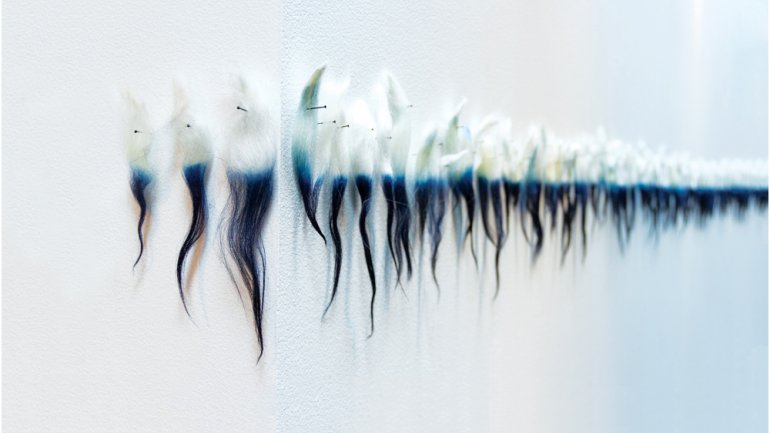Dirt to Dye
Dirt to Dye
Rowland Ricketts is happiest when he’s blue – or at least when he’s planting, harvesting, composting, and fermenting the dye-producing indigo plants he cultivates with his wife, Chinami.
The couple met in 1997 when both were apprentices at the Furusho indigo dyeing studio in Chinami’s hometown of Tokushima, Japan. Since 2006, they have lived in Bloomington, Indiana, where Rowland is assistant professor of textiles at Indiana University. Along with teaching, farming, and dyeing, Rowland channels indigo’s energy into art installations that draw attention to the source and its centuries-old traditions. For Chinami’s part, she more sparingly incorporates indigo in the yardage she weaves for kimonos and obis (sashes) using the dye-resist ikat technique.
It was in high school that Rowland first visited Japan, a trip that propelled him to study Japanese at Wesleyan University. After college, he took a job teaching English at a rural Japanese high school and lived in an old farmhouse, where he met people working with natural dyes, inspiring him to learn the process.
“Learning about plant dyes and how to garden really opened my eyes to the historical roots of craft, which is that all craft traditions are formed through the intimate relationship of people and their immediate environment – food, clothes, shelter, and the materials to meet their needs,” Rowland says.
After their apprenticeships at the Furusho studio, the couple lived in Japan for several years, with Chinami apprenticing with Yumie Aoto, a well-known ikat kimono fabric weaver, and Rowland farming indigo and dyeing textiles for clothing and interiors.
“After doing production work for a couple years, there were all these other ideas around indigo I was interested in exploring, and I felt like art was a good way of doing it,” he says.
They moved to the United States in 2003. Rowland earned an MFA in fiber at Cranbrook, followed by a one-year residency at Arrowmont School of Arts and Crafts, and then the teaching job in Bloomington; they bought their 6-acre farm just outside of town in 2008.
“The university position has really been a godsend in that it’s freed me up from worrying about how to survive, so I can make what I want,” says Rowland.
His installations, which focus on the plant and its deep hues, have included blue felted stones, billowing and bulbous sheets of cloth, videos of the plant, and even dried indigo leaves that gallerygoers can touch.
“The blue itself is not just a color, but the knowledge that is embodied with the entire process. Seeds, raising plants, harvest, drying, composting, all the way through to dyeing are so much more profound and meaningful than simply mixing the dye,” Rowland says.
The couple’s farming has been made easier with the purchase of a Japanese indigo harvester, funded through a United States Artists Fellowship awarded to Rowland in 2012. Still, the agricultural and extraction processes are laborious and lengthy – just under a year from dirt to dye. They need 440 pounds of dried indigo leaf to sustain the composting process for 100 days and concentrate the dye. The composted leaves are called sukumo, which is then fermented in an alkali liquid made from wood ash and limestone.
After years of working largely independently, the partners, who are both 44 and have three young children, will soon begin collaborating on home products.
“I’ll continue what I’ve been doing, but Rowland and I are making new designs together for things that are useful to people in their day-to-day life that highlight the indigo we grow,” says Chinami. Items will likely include textiles for table and bed.
Adding a production line creates a need for more indigo, and, like a chef lining up local produce suppliers, Rowland is expanding indigo production to nearby organic farms.
“I see it as a very meaningful way of bringing this dye and these plants into the community,” Rowland says. “That’s one of the things I love about the tradition – it’s so much bigger than the individual.”
Diane Daniel is a writer based in Florida and the Netherlands.

